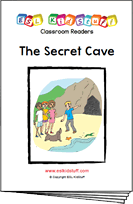Transport and travel lesson plan
Stand-alone lesson ESL kids lesson plan
Lesson plans for ESL kids teachers
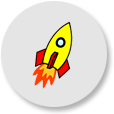
Transport and travel
In this lesson students identify and say different transport vocabulary and say how they get to school. Students play a treasure hunt and drawing game, sing a song, read a fun story and do a class survey.
Members get accompanying flashcards, worksheets, song and classroom reader.
Download materials:
Our lesson plans are FREE!
Sign up for accompanying:
✔ worksheets
✔ homework sheets
✔ craft sheets
✔ flashcards
✔ song downloads & videos
✔ classroom readers & videos
Click to see lesson details, materials and supplies
Time: 40 mins – 1 hour
Objectives: Identifying different transport vocabulary, Saying how you got to school.
Structures: “How did you get here today?”, “I got here on foot / by …”.
Target vocabulary: on foot, bus, bicycle, car, train, boat, [hide_on_uk]airplane[/hide_on_uk][hide_on_us]aeroplane[/hide_on_us], rocket.
Lesson materials
Flashcards:
- walk, bus, bicycle, car, train, boat, [hide_on_uk]airplane[/hide_on_uk][hide_on_us]aeroplane[/hide_on_us], rocket
Printables:
- How did you get here today? survey
- How did you get to school today? worksheet
- Reader worksheet
- How did you get here today? song poster
Songs:
- How did you get here today?
Readers:
- Let’s climb a mountain!
Additional materials:
- Transport and travel vocab crossword
- Transport and travel vocab word search
- Let’s go! worksheet
Supplies:
- [hide_on_uk]colored[/hide_on_uk][hide_on_us]coloured[/hide_on_us] pencils
- blank paper to give students
- board with marker / chalk
- device to play the song on
This is a nice lesson which not only teaches transportation vocabulary but also how to ask and reply to a question on how they arrived at their school.
Lesson procedure:
Warm up and maintenance:
The beginning of your lesson is extremely important: this is where you set the tone of your lesson and get everyone in the right frame of mind for learning English. It is also an opportunity to check homework and review previous lessons.
Click for warm up suggestions for the start of your lessons
These activities can be done in the following order at the start of your lesson:

1. Greetings and name tags
Greet the students by name as they enter the classroom and gesture for them to sit down. Before class prepare some blank name tags (stickers or pin-on tags). Give these out and have everyone write their names and put their tags on. If you use pin-on tags, you can keep and give out every class.

2. Homework check
Check each student’s homework set in the last lesson. Ask each student some questions about their homework worksheet (e.g. “what [hide_on_uk]color[/hide_on_uk][hide_on_us]colour[/hide_on_us] is it?”), give lots of praise, and then put some kind of mark on the homework sheet (e.g. a sticker, a stamp or draw a smiley face). Finally, tell your students to put their homework back into their bags.
3. Review past lessons
Reviewing past lessons is very important – students need constant practice of new vocab, structures, songs, games and so on. Always review parts of your last lesson as well as some parts from other previous lessons. You can spend 5-10 minutes reviewing – it’s fine to recycle games and activities from your past lessons to review as kids enjoy playing familiar games (although be careful not to play a game to death!). See the section “Other ideas to include in your warm” below for ideas.
You can also include review activities in the main body of your lesson. Kids can have short attention spans so it’s good to be able to pull out lots of activities during different stages of the lesson.
Other ideas to include in your warm up:
Ball pass questions
This is good to review questions from previous lessons. Get everybody standing in a circle.
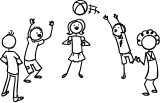
Round 1:
Take a ball and hold it and say, “My name is (you name)”. Then throw the ball to one student and say, “What’s your name?”. Students throw the ball around randomly, saying their names and asking for names.
Round 2:
This time ask a review question, e.g. “How many tables are there?”. Then throw the ball to a student who should answer, “There are (6) tables”. Help if necessary. Then that student throws the ball to another student and asks a “How many …?” question. Continue so everyone has a go. You can have multiple rounds with different topic questions.

Play “Spin the bottle”
Sit students in a circle with a bottle in the middle. Teacher spins the bottle. When it stops spinning the student it is pointing to has to answer a question. If the answer is correct then that student can spin the bottle. This is a good class warm up activity (e.g. How are you? What’s your [hide_on_uk]favorite[/hide_on_uk][hide_on_us]favourite[/hide_on_us] food? How’s the weather today?, etc.
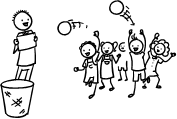
Play “Vocabulary basketball”
This is a fun game which reviews vocabulary from previous lessons. You will need a basket (a trash can) and 2 balls (or 2 pieces of A4 paper scrunched up into balls).
Form 2 teams and line them up so that two players from each team are facing the front with the basket in front of them. Let both players throw their ball – if they get their ball into the basket they can try and win a point by giving the correct answer to a question the teacher asks. This can be an actual question (e.g. What are you wearing?) or a flashcard (What’s this?). Then they go to the back of the line. At the end, the team with the most points is the winner!
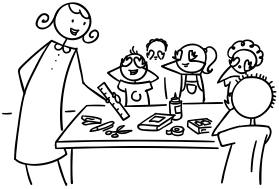
Play “What’s missing?”
This is a fun review memory game – students will have to try to remember review objects from previous lessons (e.g. classroom stationery). Lay the objects out on a table for all to see. Allow the students a minute to memorize the positions of the objects. Remove an object and hold it behind your back. Say, “Open your eyes!” – the first student who can shout out the missing object wins a point for his/her team. Play for all the objects.
Finally, calculate which team has won the most points and give them a round of applause.

Play “Quiz game show”
This is a fun quiz game, like a simple version of a TV game show. Draw some circles on the board and randomly write numbers 1, 2 or 3 in each circle. These will be points.
Put students into teams. Then ask the first team to choose a number – 1 is an easy question (e.g. “Do you like bananas?”) and 3 is a difficult question (e.g. point at a clock and ask, “What time is it?”). 2 will be in between in terms of difficulty. When the question has been answered correctly, erase that number circle. Play until all the number circles are gone – the team with the most points is the winner!
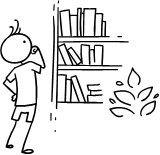
Read a classroom reader again
As you progress through the lessons you will start to build up a catalog of classroom readers (see our Readers download page at https://www.eslkidstuff.com). Kids love going back to old stories and reading through them again. Invite a student to pick a classroom reader and read through it as a class. Make the story as interactive as possible by asking questions (e.g. what [hide_on_uk]colors[/hide_on_uk][hide_on_us]colours[/hide_on_us] there are, the names of different objects, etc.) and getting students to speculate what is going to happen next in the story.
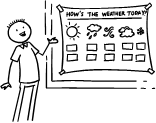
Talk about the weather (do after you have taught the weather lesson plan).
- Prepare a weather board. Before the first class prepare a piece of cardboard and cover it with felt – you are going to pin this to the wall. If you can, try and get blue felt (to represent the sky). Write at the top in large letters, “How’s the weather today?”. Below that write “Today it’s”. Cut out weather pictures (such as our weather flashcards) and stick some velcro on the back. Arrange the weather pictures around the edge of the board and then put the board on the wall of your classroom. You can now use this weather board at the beginning of every lesson.
- Ask about the weather. Ask, “How’s the weather today?” and have students put up their hands. Allow one weather condition per student (e.g. “It’s rainy”) and have each student come up and put a weather picture on the weather board.
- Introduce more weather vocabulary. Depending on weather conditions, you can introduce more weather words (with pictures … you can get students to draw them), such as:
- stormy
- misty
- showery
- freezing
- humid
- frosty
- icy
- drizzly
New learning and practice:

1. Play vocabulary flashcard treasure hunt
Before class, prepare flashcards of the vocabulary from the song (walk, bus, bicycle, car, train, boat, [hide_on_uk]airplane[/hide_on_uk][hide_on_us]aeroplane[/hide_on_us], rocket) and hide them around the classroom – behind a chair, on the window sill, in a book, etc.
In class, sit your students down and start hunting around the room, gesturing that you are looking for something. “Find” one of the flashcards and look relieved and happy to have found it. Indicate that there are 7 more flashcards to find and get everyone to hunt around the room helping you to look for the flashcards. Once all of the flashcards have been found sit everyone down again.
2. Teach the transport vocabulary
On the board, draw a simple picture of your school at one end of the board and your home (a simple house) at the other. Alternatively, you can use photos of both. Tell your students what each place is (“This is our school – here!”, “This is my house. I live here!” (maybe draw a picture of yourself above the house)).
You are going to teach the vocabulary in the order they are mentioned in the song you are going to sing a bit later on. Pull out the first card (“walk”). Put the card on the board between the school and your house. Say slowly, “I got here on foot … on foot … on foot.”, whilst doing the gesture of walking on the spot. Get all of your students to stand up and walk on the spot as they say, “on foot .. on foot …”.
Next pull out the bus flashcard and replace the walk flashcard with it on the board. This time say, “I got here by bus … by bus … by bus” whilst doing the gesture of driving a bus and beeping the horn. Get all of your students to stand up and pretend to drive a bus and beep the horn as they say “by bus … by bus …”.

Continue doing this for all of the cards and gestures from the song. For the last one – “rocket” – get everyone to count down from 10 to 1 and then jump as they blast off!

3. Play “Vocabulary art gallery”
If you have just a few students: draw some squares on the board in a row for each student to draw in (these are their picture frames). You’ll need one square (or picture frame) per student. Make sure the squares are at a good height so everyone can reach.
If you have a lot of students: give each student a piece of paper and have them draw 8 boxes (picture frames) on the paper. Tell everyone they are going to draw some pictures.
For smaller classes have your students stand in front of one of the squares on the board. Say, “Draw … I got here … by boat”). Everyone should draw a picture of a boat in their square (or the first square of the sheet of paper for students in larger classes). Give a minute for this (you can use an egg timer for fun!). When the time is up say, “STOP!”. Now, you are the judge. Walk around looking at the pictures and give some comments (“hmmm, not bad” … “oh, very nice!”, etc.). Finally, award a winner for the best drawing and get everyone to clap.
Now, erase the pictures on the board (or if using paper move onto the second square) and go onto the next vocabulary item (e.g. by bike). Again, judge the pictures and select a winner. Go through all of the pictures, each time electing a different winner – try and make sure everyone wins at least once. If you have more than 8 students you can choose joint winners.
4. Sing the “How did you get here today?” song
Put the flashcards on the board in order of the song (or use our song poster). Run through the gestures (see below) first. Then play the song and sing along doing the gestures. If this is the first time to sing the song, play it a second time.
Lyrics for “How did you get here today?”
How did you get here today?
How did you get here today?
Verse 1:
I got here on foot
I got here by bus
I got here by bicycle
I got here by car.
How did you get here today?
How did you get here today?
Verse 2:
I got here by train
I got here by boat
I got here by airplane
I got here by rocket.
Wow!
10 – 9 – 8 – 7 – 6 – 5 – 4 – 3 – 2 – 1
Blast off!
Gestures for “How did you get here today?”
Some simple actions can be used with this song:
- Do the question pose (palms up, puzzled look on face) for the question “How did you get here today?”, but point downwards (to the ground) for the “here” part.
- As the song plays do the following actions:
• on foot: walk on the spot.
• by bus: pretend to drive a bus and beep the horn.
• by bicycle: pretend to be cycling and ring a bell.
• by car: pretend to drive a car and beep the horn.
• by train: do the train gesture – moving your hands around like a wheel and “chu-chu”ing.
• by boat: do wave motions with your hands.
• by [hide_on_uk]airplane[/hide_on_uk][hide_on_us]aeroplane[/hide_on_us]: pretend to be an [hide_on_uk]airplane[/hide_on_uk][hide_on_us]aeroplane[/hide_on_us] by holding your arms right out.
• by rocket: put your arms above your head, finger tips touching to make a rocket shape. Keep this shape for the countdown and then jump for the blast off.

[hide_on_uk]Short sample (members get full-length song):
[/hide_on_uk]
[hide_on_us]Short sample (members get full-length song):
[/hide_on_us]
5. Read classroom reader “Let’s climb a mountain!”
Before class, download and print off the reader “Let’s climb a mountain!”. As you go through each page, point to the pictures, elicit each key word, and have your students say how each person got to the top of the mountain, for example:
Teacher: What is this? (pointing at the car)
Students: It’s a car!
Teacher: Yes, that’s right! How did the man get to the top of the mountain?
Students: By car.
Teacher: Let’s check … (reading from the story) … I got here by car. Right!
Get the students really involved in the story by asking lots of questions (e.g. eliciting colors) and getting them to do the actions of each vehicle.
After reading the story, give out a reader worksheet to each student and read through the story one more time (without stopping for questions, etc.) as students draw the modes of transport onto their worksheets. Then go through the answers as a class.
Alternatively, watch our video version of the reader (Internet connection required).
6. Practice asking and answering “How did you get here today?” with a class survey
Before class, print out the “How did you get here today? survey”. Draw enough columns for each student in the class and write their names at the top. Then copy enough for all of your students.
Start by modeling – hold up your survey and point out the names at the top. Choose one student and ask, “How did you get here today?”. Elicit a full answer (E.g. “I got here by bus.”) and show everyone how to fill in the survey (by drawing a circle in the correct cell). Do with a few students until everyone understands. If someone gives an impossible answer (e.g. rocket), show an expression of shock and then say, “Noooo, that can’t be right!” and have a laugh, but try to elicit their true answer. Then, give out a survey to everyone.
First, get everyone to find their own name and circle their answer. Then get everyone to mingle about asking and answering and filling in their surveys.
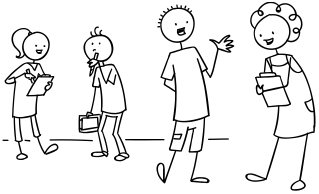
When everyone has finished, complete your survey sheet by asking the class for the answers (e.g. “How did Naomi get here today?”).
Wrap up:
Assign homework: “How did you get to school today?” worksheet
Click for wrap up suggestions for the end of your lessons

1. Assign homework
Each week give out a homework worksheet for your students to take home. Hold up the homework worksheet and model how to do it. Give out the worksheets and say, “Put your homework in your bags”.

2. Do “Quick check”
Time to leave the class. Make sure everything is put away and the students have gathered their belongings. Have them line up at the door and place yourself between the door and the students. For each student check one new word or phrase, for example:
- hold up an object or flashcard (such as an item of clothing) and ask, “What’s this?”
- ask a question from the lesson (e.g. “Where do you live?”, “Do you like bananas?”, “Can you play chess?”, etc.)
When they give you the correct answer say goodbye and let them leave. If their answer is wrong, have them go back to the end of the line – they will have to try again once they reach the front!
Other lesson plans
Actions, verbs & tenses:
- Can – for ability
- Morning routines
- Daily routines & times of the day
- Actions – Present continuous
- Future plans using “going to”
- Past tense activities – Regular verbs
- Past tense activities – Irregular verbs: Part 1
- Past tense activities – Irregular verbs: Part 2
Adjectives:
- Describing people
- Describing things
- Comparing things (Comparative adjectives)
- Comparing things (Superlative adjectives)
Adverbs:
Alphabet:
Animals:
Body:
Classroom:
Clothes:
Colors:
Colours:
Directions:
Family:
Feelings & emotions:
Food:
Health & sickness:
Holidays & festivals:
Jobs:
Likes, dislikes & favorites:
Likes, dislikes & favourites:
- Likes & dislikes
- [hide_on_uk]Favorites[/hide_on_uk][hide_on_us]Favourites[/hide_on_us] and asking why
Nature & Our world:
Numbers:
Places & where we live:
Prepositions of location:
Pronouns:
Shapes:
Shopping:
Sports:
Time, days, months, seasons:
Toys:
Transport & travel:
Weather:





